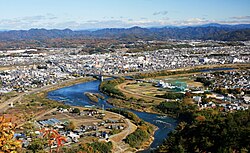Minokamo
|
Minokamo 美濃加茂市 |
|||
|---|---|---|---|
| City | |||

View of Downtown Minokamo, Kiso River and Mount Ontake, from Mount Hatobuki
|
|||
|
|||
 Location of Minokamo in Gifu Prefecture |
|||
| Coordinates: 35°26′24.8″N 137°0′56.4″E / 35.440222°N 137.015667°ECoordinates: 35°26′24.8″N 137°0′56.4″E / 35.440222°N 137.015667°E | |||
| Country | Japan | ||
| Region | Chūbu | ||
| Prefecture | Gifu | ||
| Government | |||
| • Mayor | Naoyoshi Watanabe | ||
| Area | |||
| • Total | 74.81 km2 (28.88 sq mi) | ||
| Population (December 1, 2017) | |||
| • Total | 56,638 | ||
| • Density | 760/km2 (2,000/sq mi) | ||
| Time zone | Japan Standard Time (UTC+9) | ||
| City symbols | |||
| - Tree | Aphananthe aspera | ||
| - Flower | Hydrangea | ||
| Phone number | 0574-25-2111 | ||
| Address | 3431-1 Ōta-chō, Minokamo-shi, Gifu-ken 505-8606 | ||
| Website | Official website | ||
Minokamo (美濃加茂市 Minokamo-shi) is a city located in Gifu, Japan. As of 30 November 2017[update], the city had an estimated population of 56,638 and a population density of 74.81 persons per km2, in 22,076 households. The total area of the city was 74.81 square kilometres (28.88 sq mi).
Minokamo is located in south-central Gifu Prefecture in the Nōbi Plain, between the Hida Mountains and the Kiso River.
Per Japanese census data, the population of Minokamo has increased rapidly over the past 40 years..
The city has a climate characterized by characterized by hot and humid summers, and mild winters (Köppen climate classification Cfa). The average annual temperature in Minokamo is 15.2 °C. The average annual rainfall is 1982 mm with September as the wettest month. The temperatures are highest on average in August, at around 27.9 °C, and lowest in January, at around 3.5 °C.
The area around Minokamo was part of traditional Mino Province. In the Edo period, the area was divided between the holdings of Owari Domain and Naegi Domain, and tenryō holdings directly under the Tokugawa shogunate. Ōta-juku florished as a post station on the Nakasendō highway connecting Edo with Kyoto]. In the post-Meiji restoration cadastral reforms, Kamo District in Gifu prefecture was created. The modern city was formed on April 1, 1954 by the merger of the towns of Ota and Furui with the villages of Yamanoue, Hachiya, Kamono, Ibuka, Shimoyoneda and Miwa.
...
Wikipedia



